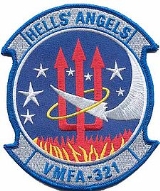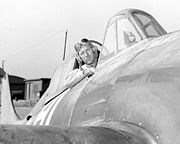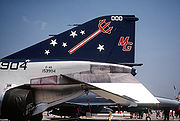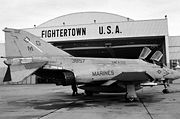
VMFA-321
Encyclopedia
Marine Fighter Attack Squadron 321 (VMFA-321) was a United States Marine Corps
fighter squadron consisting of F/A-18 Hornet
s . Known as "Hell’s Angels”, the squadron participated in action during World War II
and was then transferred to the Marine Forces Reserve. The squadron was decommissioned on September 11, 2004.
, North Carolina
, as a unit of Marine Aircraft Group 31
, 3rd Marine Aircraft Wing
. After a crash course in tactics and maneuvers, the squadron was off to the war in the South Pacific
. They were initially stationed at Vella Lavella
, a recently captured island base in the Solomon Islands
.
 First Lieutenant Robert B. See made the squadron's first "kill" four days after arriving on the island. While in the Solomon's, the 'Hell's Angels" amassed a record of 39 kills of Japanese aircraft and an additional 11 probables, with only eight aircraft lost. At one time the squadron was scoring at least one kill and/or one probable a day with its F4U Corsair
First Lieutenant Robert B. See made the squadron's first "kill" four days after arriving on the island. While in the Solomon's, the 'Hell's Angels" amassed a record of 39 kills of Japanese aircraft and an additional 11 probables, with only eight aircraft lost. At one time the squadron was scoring at least one kill and/or one probable a day with its F4U Corsair
aircraft. Captain J. R. Norman once downed four planes in a single day.
Major Edmund F. Overend, the squadron's Commanding Officer, who had come to the squadron with 5.83 credited kills from his services with the American Volunteer Group
in China
, accounted for three more confirmed kills.
The squadron transferred north to the area around Guam
, where pilots took over "milk run" bombings of neighboring islands and played a major role in knocking out Japanese bases from which attacks against American bomber bases were being launched.
area began organizing a reserve fighting squadron from the ranks of pilots, officers, and enlisted members who had served together in the war as VMF-321. This new VMF-321 became an organized Marine Corps Reserve fighting squadron in July 1946 at Naval Air Station Anacostia Maryland
, and was assigned 14 Corsair aircraft similar to the ones flown by the squadron during the war.
On April 1, 1949, Marine Fighting Squadron 321 was redesignated Marine Fighter Squadron 321. The squadron was placed on alert January 13, 1951 and was activated on March 1, 1951 flying the F8F Bearcat
during the Korean War
. The 164-man unit began an intensive training program under the command of Major George Robertshaw, in preparation for deployment to the Far East.
The squadron did not go to Korea as a unit. Instead it was declared an augmentation squadron and its members were assigned to regular Marine units to fill empty billets.
 In the 1950s , the squadron flew the A-1 Skyraider
In the 1950s , the squadron flew the A-1 Skyraider
and on May 15, 1958 they were redesignated Marine Attack Squadron 321 (VMA-321). On July 1, 1962, the squadron again became VMF-321 when it began flying the FJ-4B Fury. This was followed by a transition to the F-8 Crusader
in January 1965.
In October 1973. a new paint scheme, consisting of a black dorsal and vertical stabilizer
prompted a temporary nickname changed to the "Black Barons". However, the squadron shortly returned to the "Hell's Angels" adding a pitchfork running through the " MG" on the vertical stabilizer.
 Marine Fighter Squadron 321 was redesignated Marine Fighter Attack Squadron VMFA-321 in December 1973, when it became the first Marine Air Reserve squadron to receive the F-4 Phantom II
Marine Fighter Squadron 321 was redesignated Marine Fighter Attack Squadron VMFA-321 in December 1973, when it became the first Marine Air Reserve squadron to receive the F-4 Phantom II
aircraft. The designation, which remains today, indicated the dual fighter/attack mission. Aircrew and maintenance personnel began preparing for the new aircraft long before its arrival, and on January 15, 1974, VMFA-321 made its first Phantom flight.
Reservists from VMFA-321 appeared in a film produced for recruiting personnel into the Marine Corps Air Reserves. The film, which featured actor and former Marine Christopher George
, was produced in the summer of 1976 at Andrews Air Force Base
by J. Walter Thompson
, which has held the Marine Corps
recruiting account contract for decades.
In 1985, VMFA-321 operated twelve F-4S Phantom aircraft and accumulated 12,344 mishap free hours. During the calendar year the squadron flew nearly 3,000 hours in support of a demanding aircrew training program. VMFA-321 was nominated for the Chief of Naval Operations
Safety Award.
 In 1991, VMFA-321 stood down the Phantom and commenced transitioning to the F/A-18 Hornet
In 1991, VMFA-321 stood down the Phantom and commenced transitioning to the F/A-18 Hornet
. During 1996, they deployed to Norway and Scotland. 1998 found them back in Scotland. 1999 sent the Hells Angels to Egypt. 2000 was a third and final deployment to Scotland. 2001 saw the squadron report to NAF Washington on September 12 without prior notice. The squadron reported mission ready with 6 aircraft and pilots ready for CAP missions and actually launched sorties in support of what would become Operational Noble Eagle. The squadron was chosen for deactivation as part of the Department of the Navy’s Tactical Air Integration Plan. And after a final deployment to Karup,Denmark in June 2004, they officially stood down on September 11, 2004. Shortly after this the last CO of the squadron flew the last remaining plane belonging to the squadron to Quantico MCB where he crashed the plane on its final landing. The aircraft was repaired and it sits on display at TBS (The Basic School).
United States Marine Corps
The United States Marine Corps is a branch of the United States Armed Forces responsible for providing power projection from the sea, using the mobility of the United States Navy to deliver combined-arms task forces rapidly. It is one of seven uniformed services of the United States...
fighter squadron consisting of F/A-18 Hornet
F/A-18 Hornet
The McDonnell Douglas F/A-18 Hornet is a supersonic, all-weather carrier-capable multirole fighter jet, designed to dogfight and attack ground targets . Designed by McDonnell Douglas and Northrop, the F/A-18 was derived from the latter's YF-17 in the 1970s for use by the United States Navy and...
s . Known as "Hell’s Angels”, the squadron participated in action during World War II
World War II
World War II, or the Second World War , was a global conflict lasting from 1939 to 1945, involving most of the world's nations—including all of the great powers—eventually forming two opposing military alliances: the Allies and the Axis...
and was then transferred to the Marine Forces Reserve. The squadron was decommissioned on September 11, 2004.
World War II
VMF-321 was established February 1, 1943 at Marine Corps Air Station Cherry PointMarine Corps Air Station Cherry Point
Marine Corps Air Station Cherry Point or MCAS Cherry Point is a United States Marine Corps airfield located in Havelock, North Carolina, USA, in the eastern part of the state...
, North Carolina
North Carolina
North Carolina is a state located in the southeastern United States. The state borders South Carolina and Georgia to the south, Tennessee to the west and Virginia to the north. North Carolina contains 100 counties. Its capital is Raleigh, and its largest city is Charlotte...
, as a unit of Marine Aircraft Group 31
Marine Aircraft Group 31
Marine Aircraft Group 31 is a United States Marine Corps aviation group based at Marine Corps Air Station Beaufort, South Carolina that is currently composed of four F/A-18C squadrons, one F/A-18A+ squadron, two F/A-18D squadrons and a maintenance and logistics squadron...
, 3rd Marine Aircraft Wing
3rd Marine Aircraft Wing
The 3d Marine Aircraft Wing is the major west coast aviation unit of the United States Marine Corps. It is headquartered at Marine Corps Air Station Miramar, California and provides the aviation combat element for I Marine Expeditionary Force...
. After a crash course in tactics and maneuvers, the squadron was off to the war in the South Pacific
Pacific Ocean Areas
Pacific Ocean Areas was a major Allied military command in the Pacific Ocean theater of World War II. It was one of four major Allied commands during the Pacific War, and one of two United States commands in the Pacific Theater of Operations. Admiral Chester W. Nimitz of the U.S...
. They were initially stationed at Vella Lavella
Vella Lavella
Vella Lavella is an island in the Western Province of the Solomon Islands. It lies to the west of New Georgia, but is considered one of the New Georgia Group...
, a recently captured island base in the Solomon Islands
Solomon Islands
Solomon Islands is a sovereign state in Oceania, east of Papua New Guinea, consisting of nearly one thousand islands. It covers a land mass of . The capital, Honiara, is located on the island of Guadalcanal...
.

F4U Corsair
The Vought F4U Corsair was a carrier-capable fighter aircraft that saw service primarily in World War II and the Korean War. Demand for the aircraft soon overwhelmed Vought's manufacturing capability, resulting in production by Goodyear and Brewster: Goodyear-built Corsairs were designated FG and...
aircraft. Captain J. R. Norman once downed four planes in a single day.
Major Edmund F. Overend, the squadron's Commanding Officer, who had come to the squadron with 5.83 credited kills from his services with the American Volunteer Group
American Volunteer Group
The American Volunteer Groups were volunteer air units organized by the United States government to aid the Nationalist government of China against Japan in the Second Sino-Japanese War...
in China
China
Chinese civilization may refer to:* China for more general discussion of the country.* Chinese culture* Greater China, the transnational community of ethnic Chinese.* History of China* Sinosphere, the area historically affected by Chinese culture...
, accounted for three more confirmed kills.
The squadron transferred north to the area around Guam
Guam
Guam is an organized, unincorporated territory of the United States located in the western Pacific Ocean. It is one of five U.S. territories with an established civilian government. Guam is listed as one of 16 Non-Self-Governing Territories by the Special Committee on Decolonization of the United...
, where pilots took over "milk run" bombings of neighboring islands and played a major role in knocking out Japanese bases from which attacks against American bomber bases were being launched.
The Cold War
After the war, the squadron returned home and was deactivated on January 28, 1946. Early in 1946 a group of Marine aviators in the Washington, D.C.Washington, D.C.
Washington, D.C., formally the District of Columbia and commonly referred to as Washington, "the District", or simply D.C., is the capital of the United States. On July 16, 1790, the United States Congress approved the creation of a permanent national capital as permitted by the U.S. Constitution....
area began organizing a reserve fighting squadron from the ranks of pilots, officers, and enlisted members who had served together in the war as VMF-321. This new VMF-321 became an organized Marine Corps Reserve fighting squadron in July 1946 at Naval Air Station Anacostia Maryland
Maryland
Maryland is a U.S. state located in the Mid Atlantic region of the United States, bordering Virginia, West Virginia, and the District of Columbia to its south and west; Pennsylvania to its north; and Delaware to its east...
, and was assigned 14 Corsair aircraft similar to the ones flown by the squadron during the war.
On April 1, 1949, Marine Fighting Squadron 321 was redesignated Marine Fighter Squadron 321. The squadron was placed on alert January 13, 1951 and was activated on March 1, 1951 flying the F8F Bearcat
F8F Bearcat
The Grumman F8F Bearcat was an American single-engine naval fighter aircraft of the 1940s. It went on to serve into the mid-20th century in the United States Navy and other air forces, and would be the company's final piston engined fighter aircraft...
during the Korean War
Korean War
The Korean War was a conventional war between South Korea, supported by the United Nations, and North Korea, supported by the People's Republic of China , with military material aid from the Soviet Union...
. The 164-man unit began an intensive training program under the command of Major George Robertshaw, in preparation for deployment to the Far East.
The squadron did not go to Korea as a unit. Instead it was declared an augmentation squadron and its members were assigned to regular Marine units to fill empty billets.

A-1 Skyraider
The Douglas A-1 Skyraider was an American single-seat attack aircraft that saw service between the late 1940s and early 1980s. It became a piston-powered, propeller-driven anachronism in the jet age, and was nicknamed "Spad", after a French World War I fighter...
and on May 15, 1958 they were redesignated Marine Attack Squadron 321 (VMA-321). On July 1, 1962, the squadron again became VMF-321 when it began flying the FJ-4B Fury. This was followed by a transition to the F-8 Crusader
F-8 Crusader
The Vought F-8 Crusader was a single-engine, supersonic, carrier-based air superiority jet aircraft built by Vought for the United States Navy and the U.S. Marine Corps, replacing the Vought F7U Cutlass...
in January 1965.
In October 1973. a new paint scheme, consisting of a black dorsal and vertical stabilizer
Vertical stabilizer
The vertical stabilizers, vertical stabilisers, or fins, of aircraft, missiles or bombs are typically found on the aft end of the fuselage or body, and are intended to reduce aerodynamic side slip. It is analogical to a skeg on boats and ships.On aircraft, vertical stabilizers generally point upwards...
prompted a temporary nickname changed to the "Black Barons". However, the squadron shortly returned to the "Hell's Angels" adding a pitchfork running through the " MG" on the vertical stabilizer.

F-4 Phantom II
The McDonnell Douglas F-4 Phantom II is a tandem two-seat, twin-engined, all-weather, long-range supersonic jet interceptor fighter/fighter-bomber originally developed for the United States Navy by McDonnell Aircraft. It first entered service in 1960 with the U.S. Navy. Proving highly adaptable,...
aircraft. The designation, which remains today, indicated the dual fighter/attack mission. Aircrew and maintenance personnel began preparing for the new aircraft long before its arrival, and on January 15, 1974, VMFA-321 made its first Phantom flight.
Reservists from VMFA-321 appeared in a film produced for recruiting personnel into the Marine Corps Air Reserves. The film, which featured actor and former Marine Christopher George
Christopher George
Christopher John George was an American television and film actor who was perhaps best known for his starring role in the 1966-1968 TV series The Rat Patrol. He was nominated for a Golden Globe in 1967 as Best TV Star for his performance in the series...
, was produced in the summer of 1976 at Andrews Air Force Base
Andrews Air Force Base
Joint Base Andrews is a United States military facility located in Prince George's County, Maryland. The facility is under the jurisdiction of the United States Air Force 11th Wing, Air Force District of Washington ....
by J. Walter Thompson
JWT
JWT is one of the largest advertising agencies in the United States and the fourth-largest in the world. It is one of the key companies of Sir Martin Sorrell's WPP Group and is headquartered in New York. The global agency is led by Worldwide Chairman and Global CEO Bob Jeffrey who took over the...
, which has held the Marine Corps
Marine corps
A marine is a member of a force that specializes in expeditionary operations such as amphibious assault and occupation. The marines traditionally have strong links with the country's navy...
recruiting account contract for decades.
In 1985, VMFA-321 operated twelve F-4S Phantom aircraft and accumulated 12,344 mishap free hours. During the calendar year the squadron flew nearly 3,000 hours in support of a demanding aircrew training program. VMFA-321 was nominated for the Chief of Naval Operations
Chief of Naval Operations
The Chief of Naval Operations is a statutory office held by a four-star admiral in the United States Navy, and is the most senior uniformed officer assigned to serve in the Department of the Navy. The office is a military adviser and deputy to the Secretary of the Navy...
Safety Award.
1990–2004

F/A-18 Hornet
The McDonnell Douglas F/A-18 Hornet is a supersonic, all-weather carrier-capable multirole fighter jet, designed to dogfight and attack ground targets . Designed by McDonnell Douglas and Northrop, the F/A-18 was derived from the latter's YF-17 in the 1970s for use by the United States Navy and...
. During 1996, they deployed to Norway and Scotland. 1998 found them back in Scotland. 1999 sent the Hells Angels to Egypt. 2000 was a third and final deployment to Scotland. 2001 saw the squadron report to NAF Washington on September 12 without prior notice. The squadron reported mission ready with 6 aircraft and pilots ready for CAP missions and actually launched sorties in support of what would become Operational Noble Eagle. The squadron was chosen for deactivation as part of the Department of the Navy’s Tactical Air Integration Plan. And after a final deployment to Karup,Denmark in June 2004, they officially stood down on September 11, 2004. Shortly after this the last CO of the squadron flew the last remaining plane belonging to the squadron to Quantico MCB where he crashed the plane on its final landing. The aircraft was repaired and it sits on display at TBS (The Basic School).
See also
- United States Marine Corps AviationUnited States Marine Corps AviationUnited States Marine Corps Aviation is the air component of the United States Marine Corps. Marine aviation has a very different mission and operation than its ground counterpart, and thus, has many of its own histories, traditions, terms, and procedures....
- List of inactive United States Marine Corps aircraft squadrons

